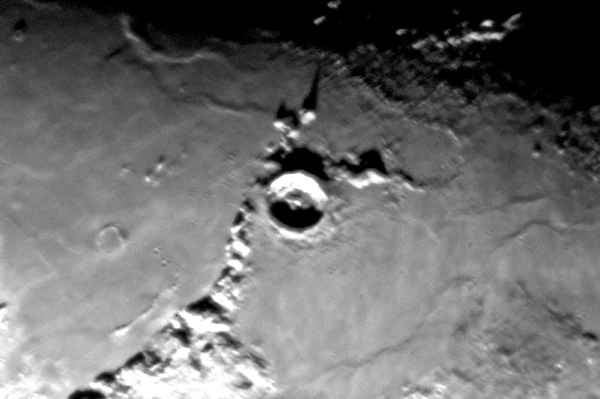
ISS (!!!), Moon, Arcturus Spectrum Tests
Posted: 30 April 2012
Cassiopeia Observatory was opened Sunday, 29 April, at 1857 MST, 85°F. Viewed Venus, 77X, at 1901 MST. I then updated the ISS TLE in the telescope for the night's pass. I then took a quick look at the moon, 77X. I selected the Crater Eratosthenes for imaging after the ISS pass was over. Next, I began preparations for imaging the ISS at prime focus of the 8" LX200-ACF using the D7000 DSLR. The exposure setting was 1/2000sec, ISO 2000. I mounted the camera on the telescope, focused on the moon, and did a HD (1920x1080, 24fps) video recording test. Slewed to Venus for a finderscope alignment check; made a slight tweak in the alignment. At 1919 MST, I was ready for the ISS pass that would start at 1940 MST.
Pointing at AOS was way off again this night. But once I got the ISS centered in the finderscope, tracking was OK sometimes. Several frames on the 6m30s video captured some nice views of the ISS. This image shows four views of the ISS as the orientation changed during the pass. The images are cropped (a lot) from the original HD video frames and are at the same scale. The left two frames are at about the mid-point of the pass as the ISS was almost directly overhead. The right two frames are from near the end of the pass with the ISS about 30° above the eastern horizon.

At 1956 MST, I returned to the moon for some imaging. This is a prime focus, 1/320sec, ISO 500, exposure:

This is a prime focus + 3X TeleXtender, 1/160sec, ISO 1600, exposure, showing Crater Plato (upper left) and Crater Eratosthenes (far right):

Crater Plato, prime focus + 3X TeleXtender, "Hat Trick", ISO 100, cropped from the full-frame image:

Crater Eratosthenes, prime focus + 3X TeleXtender, "Hat Trick", ISO 250, cropped from the full-frame image:

I ended lunar imaging at 2015 MST and began some lunar terminator observing, 206X. Seeing was not ideal, but at times, the views along the terminator were great.
I then slewed to the star Arcturus to make some exposure tests in an attempt to better capture the Fraunhofer lines using the Star Analyzer. I have been concerned that some lines that have appeared in my earlier spectral images were from noise in the digital image. Here are three exposures, cropped to show just the spectra of Arcturus, spectral type K1:
1/200sec, ISO 2000:
![]()
1/200sec, ISO 2000:
![]()
1/200sec, ISO 2000:
![]()
These are the same three exposures (same order), processed by reducing the height to 1 pixel and then expanding it to 30 pixels (as recommended in the Star Analyzer manual):
1/200sec, ISO 2000:
![]()
1/200sec, ISO 2000:
![]()
1/200sec, ISO 2000:
![]()
For comparison, here is a spectrum of Arcturus from the Rigel Systems RS-Spectroscope page on the OPT web site, also set to 30 pixels:
![]()
Quite a lot of difference in the images. Which lines are real in my images and which are artifacts? Good question. More tests are needed. After completing the exposures, I viewed Arturus at 77X with the Star Analyzer. Only one line was visible; it was at the far blue end of the spectum.
Now that I have an iPad that I will use in the observatory, I have begun thinking about a holder or table on which to place it. It will rest securely on my POD Roller Desk, but I am thinking something closer to the eyepiece would be more convenient. One option is the Orion Mounting Bracket with Tripod Adapter for iPad/Tablets, but that would require placing a photographic tripod in the POD, which would take up floor space. Alternatively, it might be possible to mount the iPad using the Orion bracket on the piggyback camera adapter on the telescope tube. But I don't know if the adapter and bracket are secure and strong enough to hold the iPad at the proper orientation as the telescope slews. Another possible option might be the RAM Spring Loaded iPad Cradle with Yoke Mount from Sporty's Pilot Shop. This cradle might attach to a LX200 tripod leg using the clamp, but it appears that the iPad dock connector is blocked, meaning it would work only with the SkyFi (which I don't have) and not with the SkyWire (which I do have).
So, for now, I am designing a small flat surface on which to place the iPad with the SkyWire cable connected. I cut a piece of thick cardboard to match the dimensions of the iPad. While waiting for the ISS pass to start and after completing the spectrum tests, I did some iPad placement experiments using the cardboard "iPad stand-in", checking where a surface could be attached, either to the POD or to the telescope tripod. I have come up with a possible solution, which I will prototype. Stay tuned.
Closed the observatory at 2108 MST, 68°F.
Comments are welcome; use the Comments section below, or you can Email Me. Thanks.
Go to the previous report.
Return to the Cassiopeia Observatory Welcome Page.